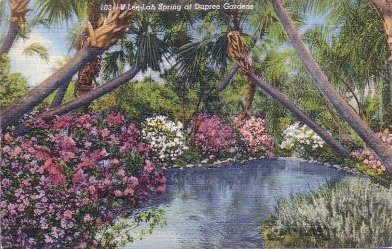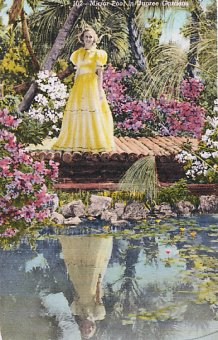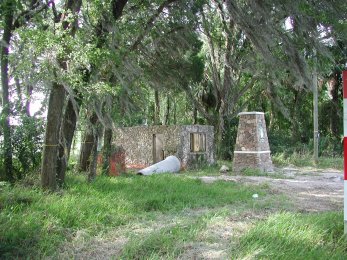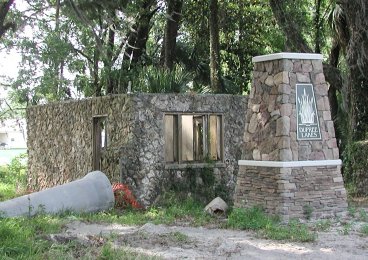HISTORY OF PASCO COUNTYDupree Gardens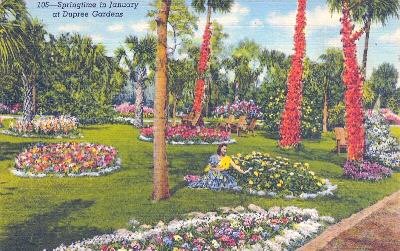 The following article is taken from The Historic Places of Pasco County, by James J. Horgan, Alice F. Hall, and Edward J. Herrmann. J. William Dupree, a prominent Tampa attorney with a penchant for gardening, developed a 25-acre “Blossom Center of Florida” on this site, which flourished as a major tourist attraction during World War II. After injuries sustained in an auto accident kept him from his profession for an extended period, Dupree began to develop an ever-expanding garden on his 900-acre country estate near Ehren. At the encouragement of his friends, he decided to open part of his beauty spot to the public. It would have been hard to find poorer timing for the venture, for it was 1941 and the eve of war. Dupree Gardens was a feature-rich attraction: the lodge had a gift shop and restaurant, and electric-powered boats skimmed the lake that fronted the lodge. Visitors thronged to see the gardens – as many as 30,000, many of them servicemen and women – from throughout the nation during the annual November 15 to May 1 season. […] With America’s growing involvement in World War II, however, Dupree Gardens was affected. Gas and tire rationing restricted tourist traffic. Dupree attempted to organize bus tours from Tampa, but there was not enough business. In compliance with wartime regulations things had to be cut back. In 1943, the kitchen and gift shop were closed, and then the electric boat trips were eliminated. Finally government officials issued a ban on unnecessary private travel and Dupree posted signs reading: “Closed for the Duration.” The gardens did play a role in the inauguration of daily direct air service between Tampa and New York City by National Airlines on October 3, 1944. The 14-passenger Lockheed Lodestar which made the six-hour-and-20-minute trip carried not only a humidor of fine Havana cigars for New York Mayor Fiorello LaGuardia, but also camellia blooms from Dupree Gardens, which were to be auctioned for the war effort. The flowers created a sensation when airline president Ted Baker placed the winning bid for them by pledging to buy $250,000.00 in war bonds. Florists on Park, Madison, and Fifth Avenues were amazed with the quality of the blossoms, finding it “inconceivable that Florida could offer fully-matured camellias in this season.” Newspapers reported that the flowers were displayed on black velvet backgrounds for maximum impact and appropriately credited to Dupree Gardens. The Dupree Gardens lodge still stands and is the residence of the current owner, Fran Hendrix; the rest of the former estate has been developed into houses. The only external reminder of the once magnificent attraction is the old native-rock ticket booth.
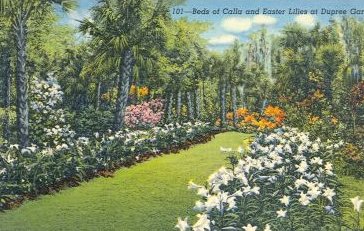 25 Acres of Joy (1942)The following article appeared in the Florida Times-Union on March 22, 1942. By MacDONALD BRYAN Snapdragons, poppies; pansies and iris; violets, sweet [alyssum] and candytuft; calendulas, delphinium and narcissus – great medallions of them on the evergreen carpets of grass – all these are there with their yearly vindication of the sweet promise of new life and new hope. In richer bloom, too, are the thousands of azaleas. Their colors range from the soft tones to the flamboyant. Great magnolias, orchid trees, redbud and dogwood have put on their fanciest garbs in obeisance to Spring. Bold flame vines make dramatic splashes of color as they climb skyward to the topmost branches of towering palms. Chaste Easter lilies and callas march along the borders of paths, and waxy camellias top, it would seem, every stem of giant bouquet-like bushes. Dupree Gardens are 25 acres of a fresh source of joy to lovers of horticulture. Interlinking trails play their part in the skillful blending carried out under the direction of J. W. Dupree, the Tampa attorney, whose love of flowers caused him to create this beauty spot on his 900-acre estate. 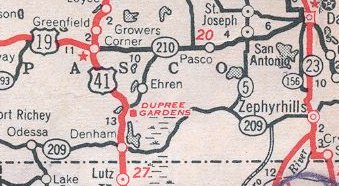 Faded Dupree Gardens to Vanish (2002)The following is excerpted from a St. Petersburg Times article of Sept. 2, 2002. In 2004, a Tampa company called Beazer Land Development plans to subdivide part of the original garden grounds into the first of more than 1,000 homes. In good news for old-time Pasco County residents who enjoyed the gardens in their youth, Beazer plans to save the ticket booth as part of a nature preserve on the property. Other traces of the park, mostly old trees and shrubs, survive near streets such as Dupree Drive, Eden Lane and Mary Jane Lane southeast of U.S. 41 and Ehren Cutoff. Even Busch Gardens employees are known to have made excursions to Land O’ Lakes to find specimens for the Tampa theme park. “I wish the gardens could still be there. But if you drive through it you can see it. The plants are still there. Nobody ripped them out,” said amateur Pasco County historian Eddie Herrmann, who visited the gardens as a boy in the early 1940s. … The Dupree property eventually split among various owners. The Island Group bought a piece to start a nudist camp on Dupree Lake. An even bigger chunk became the Dupree Gardens Estates neighborhood. The rest ended up as a 400-acre orchard owned by T & W Groves. Those with keen eyes can glimpse the old ticket booth, an small rectangular building of rough mortared limestone, squatting under trees off Ehren Cutoff. Two other buildings from the garden days, the rustic log lodge and guest house are now privately owned homes on Mary Jane Lane. As the heart of the former gardens, Mary Jane remains shrouded in oak, palm and cypress, leafy vines running amok. The Woolf family, owners of the lodge, keeps memorabilia from the gardens. They have the lodge’s original piano, still covered in cypress bark in keeping with Dupree’s “mock-primitive style.” A final building, the nearby “tea room” on Dupree Drive, burned to the ground in 1995, killing a woman who lived there since shortly after the gardens closed. Herrmann and other historically minded Pasco residents dedicated a roadside plaque to Dupree Gardens in April. Attending was Mary Conover, Dupree’s daughter; and Herbert Carrington, his former chauffeur, now more than 100 years old.
what is left of the the ticket booth, which the developer has agreed to leave standing. The historic marker was dedicated on April 20, 2002. War Wilts Dupree Gardens (2002)This article appeared in the Tampa Tribune on Nov. 1, 2002. By CAROL JEFFARES HEDMAN There was no big, talking mouse. The place didn’t have a twisting, looping roller coaster. But for a brief time in the 1940s, 25 acres of lush flora in central Pasco County drew tourists from around the country as one of the first roadside attractions in the state. Called Dupree Gardens, it began as a pastime for J. William Dupree. The Tampa attorney was injured in a car accident in 1933 that left him recuperating for an extended period. He retreated to the 900 acres he had bought for hunting in Pasco County. Located east of what was then State Road 5, now U.S. 41, and Ehren Cutoff, Dupree built a log cabin and spent his days planting an exotic garden of flowers, fruit trees and palms. The gardens were so beautiful that Dupree’s friends persuaded him to open the property to the public. Billed as the “Blossom Center of Florida,” Dupree Gardens opened Dec. 1, 1940. The gardens had a lodge, complete with a gift shop and tearoom. Electric-powered glass-bottom boats floated around Dupree Lake fronting the lodge. Dupree Gardens was an immediate success. Some 42,000 tourists visited the first year. It was no wonder with rave reviews like that by Jacksonville journalist MacDonald Bryan, who wrote in the Florida Times-Union on March 22, 1942: “Snapdragons, poppies; pansies and iris; violets, sweet alyssum and candytuft; calendulas, delphinium and narcissus – great medallions of them on the evergreen carpets of grass – all these are there with their yearly vindication of the sweet promise of new life and new hope. “In richer bloom, too, are the thousands of azaleas. Their colors range from the soft tones to the flamboyant. Great magnolias, orchid trees, redbud and dogwood have put on their fanciest garbs in obeisance to spring. Bold flame vines make dramatic splashes of color as they climb skyward to the topmost branches of towering palms. Chaste Easter lilies and callas march along the borders of paths, and waxy camellias top, it would seem, every stem of giant bouquet-like bushes. “Dupree Gardens are 25 acres of a fresh source of joy to lovers of horticulture. Interlinking trails play their part in the skillful blending carried out under the direction of J. W. Dupree, the Tampa attorney, whose love of flowers caused him to create this beauty spot on his 900-acre estate.” War Brings Cutbacks Visitors, many service men and women, from throughout the nation thronged to see the gardens during the tourist season Nov. 15 to May 1. But timing was bad for Dupree Gardens. World War II brought gas and tire rationing, restricting tourist traffic. Dupree unsuccessfully attempted to organize bus tours from Tampa. And in compliance with wartime regulations, the gardens had to make cutbacks. The kitchen and gift shop were closed in 1943. Then the electric-powered boats on the lake were stopped. The final blow came when the government issued a ban on unnecessary private travel. Dupree posted what had become a familiar sign: “Closed for the Duration.” But Dupree kept up his gardens and they even played a part in the war effort in 1944. That Oct. 3, National Airlines marked its inaugural daily direct air service between Tampa and New York City with a 14-passenger Lockheed Lodestar making the six-hour and 20-minute trip carrying a humidor of Havana cigars for New York Mayor Fiorello LaGuardia. The plane also carried camellia blooms from Dupree Gardens that were auctioned for the war effort. The blossoms made headlines when airline president Ted Baker won the bid with a pledge of $250,000 in war bonds. The blossoms, displayed on black velvet backgrounds, were said to have amazed florists on Park, Madison and Fifth avenues who found it “inconceivable that Florida could offer fully matured camellias in this season.” Dupree Gardens was reopened for a brief time in 1946, mostly for civic events and private family gatherings. Dupree sold the property in the early 1950s, with some of it developed as home sites and a parcel that included Dupree Lake opened as a nudist camp. Some 400 acres were citrus groves. The lodge was converted into a private residence. The tearoom burned in 1995. And the native lime rock ticket booth stood for years as the only reminder of the once-popular attraction. Although the site was listed in the 1992 edition of Historic Places of Pasco County, compiled by members of the Pasco County Historical Preservation Committee, a marker designating the location wasn’t erected until earlier this year. In August, a developer announced plans to build about 1,100 homes, plus some commercial space, on 471 acres that includes the Dupree Gardens site. Beazer Homes plans to save the ticket booth as part of a nature preserve. Some of the original flora still grows on the property, and plans are to use the name and history of Dupree Gardens in marketing. |

